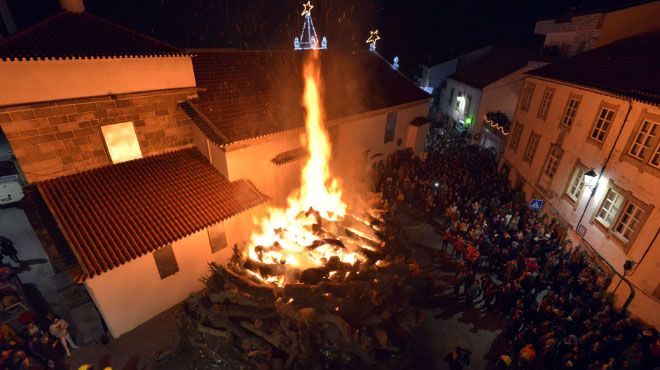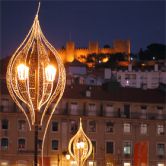The Yule-Log

Other
In the heart of Portugal, in the inland region, Christmas is marked by the ceremony known as the "burning of the yule-log", on Christmas Eve night. This ceremony is particularly popular in the area stretching from Trás-os-Montes to the Alto Alentejo, covering towns and villages in the districts of Bragança, Guarda, Castelo Branco and Portalegre.
This ritual is essentially a community celebration, being an occasion when the private habit of gathering together around the fire is brought outside the home helping to consolidate the cohesiveness of the local group. A huge bonfire is made in the churchyard, or in another similar space where the local population can meet after the Missa do Galo. The bonfire can sometimes be as high as the church and is left to burn all night long until it finally goes out. What remains is then stored away and used throughout the winter.
The lighting of the bonfire is preceded by the ritual gathering of the wood, which is then transported to the site of the bonfire by different means depending on the respective region. In some places, the logs or tree stumps that are to be used in the communal bonfire are immediately put to one side when the wood is gathered at the beginning of the winter. In other places, a special group of people is formed to gather the wood, an activity which takes place either on 8 December (the day of the Immaculate Conception), or a few days before Christmas or even on Christmas Eve itself, to ensure that everything will be ready for the night. The wood can be either offered or stolen, which does not in any way alter the actual performance of the various tasks, although it may change the way in which the wood arrives at the site of the bonfire. If the wood is given, there will be a party held with great pomp and circumstance, at which the person offering the wood will also distribute wine to those present. If the wood is stolen, then it is left at the site of the bonfire early in the morning, in anticipation of the owner´s subsequent protests.
In some villages in the district of Castelo Branco, this ritual has developed a number of specific features that have been maintained over the years. Here, the task of gathering the logs is entrusted to the young unmarried men and those who have been called up for military service. In recent times, married men have also begun to help in gathering the wood, due to the changes in everyday habits and the decrease in population as a result of the colonial wars and emigration.
The wood is cut and transported either on Christmas Eve or on the preceding Sunday. In the village, the local population waits for the group´s arrival, which is announced by the church bells, transforming this event into a moment of great celebration, frequently accompanied by music and singing. At midnight, the bonfire is lit to coincide with the beginning of the mass.





 Explore
Explore 
 Remember and Share
Remember and Share 


